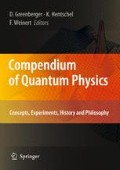The CPT theorem is a theorem for local relativistic quantum field theories in Minkowski space-time. Here, C means ‘charge conjugation’, P ‘parity transformation’ (‘space inversion’), and T ‘time inversion’; while C and P are implemented by ► unitary operators, T is implemented by an antiunitary operator. The CPT theorem states that these field theories are invariant under the combined combination of C, P, and T; one therefore speaks of CPT symmetry. The original proof by Gerhart Lüders [1] and Wolfgang Pauli [2] was performed within Lagrangian field theories; Res Jost then presented a more general proof using axiomatic quantum field theory [3].
Access this chapter
Tax calculation will be finalised at checkout
Purchases are for personal use only
Literature
G. Lüders: On the Equivalence of Invariance under Time Reversal and under Particle-Anti-Particle Conjugation for Relativistic Field Theories. K. Dan. Vidensk. Selsk. Mat.-fys. Medd. 28(5), (1954)
W. Pauli: Exclusion Principle, Lorentz Group and Reflection of Space-Time and Charge. In Niels Bohr and the Development of Physics, ed. by W. Pauli (Pergamon Press, New York 1955, 30–51)
R. Jost: Eine Bemerkung zum CPT-Theorem. Hel. Phys. Acta 30, 409–416 (1957)
W.-M. Yao et al.: The Review of Particle Physics. J. Phys. G: Nucl. Part. Phys. 33, 1 (2006)
R.F. Streater, A.S. Wightman: PCT, Spin and Statistics, and All That (Princeton University Press, Princeton 2000).
O.W. Greenberg: Why is CPT fundamental? Found. Phys. 36, 1535–1553 (2006). A related online version is http://arxiv.org/abs/hep-ph/0309309.
Editor information
Editors and Affiliations
Rights and permissions
Copyright information
© 2009 Springer-Verlag Berlin Heidelberg
About this chapter
Cite this chapter
Kiefer, C. (2009). CPT Theorem. In: Greenberger, D., Hentschel, K., Weinert, F. (eds) Compendium of Quantum Physics. Springer, Berlin, Heidelberg. https://doi.org/10.1007/978-3-540-70626-7_42
Download citation
DOI: https://doi.org/10.1007/978-3-540-70626-7_42
Published:
Publisher Name: Springer, Berlin, Heidelberg
Print ISBN: 978-3-540-70622-9
Online ISBN: 978-3-540-70626-7
eBook Packages: Physics and AstronomyPhysics and Astronomy (R0)

